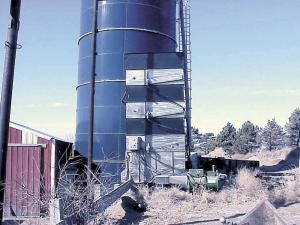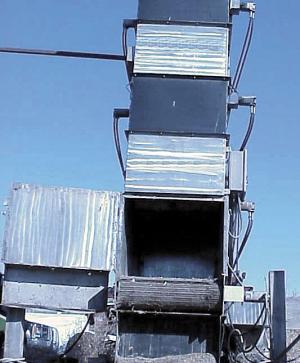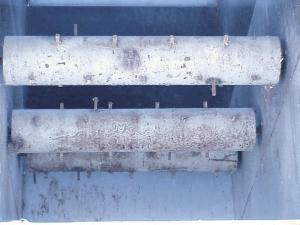2000 - Volume #24, Issue #2, Page #11
[ Sample Stories From This Issue | List of All Stories In This Issue | Print this story
| Read this issue]
Hay Dryer Speeds Harvest And Improves Feed Value
 |
 |
 |
Tom Schechinger, a Sioux City, Iowa, farmer and entrepreneur, thinks he's come up with a reasonable way to dry hay economically while maintaining feed value.
"Imagine five railroad box cars, each stacked on top of each other," he says. Inside the top four cars are several rollers with fingers on them along the bottom of each floor. Material bridges up on these as it falls in, so you can fill one compartment at a time. The bottom-most compartment has a perforated floor and sits over an air duct and a fan, just like a bin grain dryer. "You size the fan and air flow just as you would for corn. If your dryer held 5000 bu. of corn - 28,000 lbs. - you could use the same size fan to dry 28,000 lbs. of hay," he explains.
Here's how it works. Forage is brought in from the field wilted but still wet enough that leaves don't shatter. It's conveyed into the top-most compartment and air is blown up from the bottom to dry it gently. After it's dried a little, the rollers in the bottom of the compartment are turned, and the fingers move the material into the next lower compartment. Once dry hay has been moved down, the top compartment can be refilled. This process is continued until hay reaches the bottom and is dry enough to be stored. As it comes out of the dryer, it can be baled or compressed for transportation, if needed.
Tom says the dryer could be used for all types of bulky materials. He and his brother John have a built a 2 by 7 by 15-ft. working model of the dryer and they hope to build production models soon. It's owned in part by a group of farmers and investors that own Biomass Agri Products, LLC. Biomass Agri Products collects, harvests and stores bulky biomass materials for other companies. "We also do some of the simple processes for companies such as grinding and plant material separation. Each part of the plant - the pith, the fiber, the leaf, etc. û has its own market," Tom explains.
Contact: FARM SHOW Followup, Tom Schechinger, Iron Horse Farms, Inc., 816 Ironwood Rd., Harlan, Iowa 51537 (ph 712 744-3296).

Click here to download page story appeared in.

Click here to read entire issue
To read the rest of this story, download this issue below or click here to register with your account number.




